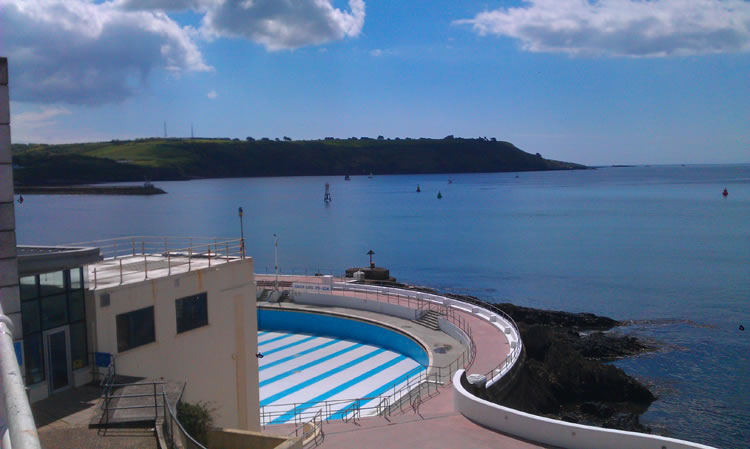WE EXPLORE LIDOS THAT WERE PART OF THE LIDO MOVEMENT IN THE 'BOROUGHS' OF TWICKENHAM AND RICHMOND
The heyday of the lido was an exciting time - in many places a holiday on the doorstep. In the case of recent renovations they have been updated to such an extent that they have been described as a mini-Med holiday.
Going to a lido was a fun day out; a place to relax and socialise. This project looks at what our lidos meant to local people.
Making a Splash
Lidos Alive Exhibition
The Richmond Environmental Information Centre at Alexander Pope Hotel, Twickenham, 23rd April
A review by Mark Aspen
There is something special about bathing in the open air. Lusty types brave the icy Serpentine on Christmas Day or swim the Channel. Yes, it was ever so. According to Shakespeare’s Cassius, Julius Caesar challenged him to swim the turbulent Tiber:
“For once, upon a raw and gusty day,
The troubled Tiber chafing with her shores,
Caesar said to me 'Darest thou, Cassius, now
Leap in with me into this angry flood,
And swim to yonder point?'”
Cassius took up the challenge, but had to rescue Caesar from drowning.
In contrast, for most of us, a nice summer’s day, swimming in safely contained (and preferable clean and well heated) waters seems much more civilised. Hence the rise of the Lido. The heyday of the lido concept was in the 1920s and 30s and, like many things, was wiped out by the Second World War. However, there is a renewed interest in the Lido and in the whole “lifestyle” concept that went with it.
Between the wars, the pre-1965 Boroughs of Twickenham and Richmond had a rich heritage of lidos and outdoor bathing, and a charity, The Richmond Environmental Information Centre (REIC) has recently been awarded a Heritage Lottery Fund grant to carry out a “memories project” about the these lidos. This formed the basis of the exhibition at The Alexander Pope on St George’s Day.
This weekend I was in Plymouth, and saw the splendidly restored Tinside Lido, which is reopening on 26th May, so it is not only in Richmond upon Thames that the interest is reviving. Built in 1935 for the Silver Jubilee of King George V, the Tinside Lido is a grade II listed building and a magnificent example of the Art Deco style.

Also built in 1935, the Silver Jubilee Year, Twickenham Lido was another such magnificent Art Deco example, and forms the prime example of the Lidos Alive project, running in conjunction with REIC. Twickenham Lido was closed for refurbishment in 1980 and has never reopened. It currently languishes in the centre of the controversial Twickenham Riverside planned development, where the creation of equally magnificent buildings is in abeyance. Twickenham Lido was enormous, and had two shallow ends, each with its own tall “wedding cake” three-storey fountain.
There were eleven major lido sites in Richmond upon Thames that were mapped out in the exhibition. Of these only Hampton Pool (1922, but refurbished in 1985 after a four year closure) and the modern Pools on the Park (1966) remain. Some of these had wonderful names, such as the Palm Beach Lido on Taggs Island or The Nook, one of two pools in Bushy Park itself. The second Bushy Park pool, near Upper Lodge, was the more rustic Bushy Bathing Pool, much beloved between the wars by local schoolboys.
Schoolboys seem to have had a penchant for open-air swimming, sometimes unauthorised, as witnessed by an Edwardian photograph in the exhibition of a long-skirted policewoman brandishing a long cane who is chasing away from the Serpentine a gaggle of naked young boys!
The exhibition, largely the brainchild of REIC Vice Chairman Berkley Driscoll, included six information boards with photographs of past and present lidos in the area, and two freestanding displays about Lidos Alive. There were continuous large screen projections, of images and maps, and a looped television screen showing interviews from within the memory project.
Informative, lively, and evocative, this exposition attracted a steady stream of absorbed visitors, and much interactive discussion. The atmosphere was charged with nostalgia and regret for the loss of these social and sporting hubs, and much support for the Lido Alive campaigning to conserve what we have left.
Visitors were presented with complimentary copies of the very interesting Lidos Alive booklet, sixteen packed pages detailing information on the lidos in the project. Moreover, the culmination of the evening’s exhibition was a launch presentation for Lidos Alive, A History Of Our Lidos, a soon-to-be published book, featuring many dynamic paintings by local artist Dennis Gilbert.
Nevertheless, Lidos Alive is not simply about sentimental yearnings for past times. There is a very active thread looking towards the future. Architecture students from Richmond upon Thames College have been developing many highly imaginative ideas for a local lido of the future, Scandinavian, Polynesian, Japanese or Roman influences; marble, wood, acrylics; geometric designs, minimalism, infinity pools; all flowing from fertile young minds. From next year, the lido project may form part of its programme for new students, in which drawings and models of the students’ creative ideas for a lido in Twickenham will form part of their coursework
Outside of Britain, the word lido conjures up images of the Lido di Venezia on edge of Venice, or in Italy itself perhaps nothing more than a beach. But, in deference to its Italian origin, REIC insists that we use the pronunciation “lee-doh”. Julius Caesar would be pleased. Maybe he would like the idea of a warm, clean, calm infinity pool by the Thames at Twickenham. Much safer than a tempestuous Tiber and, that word summarising what Ancient Rome was all about … civilised!
Photography by: Mark Aspen (Tinside Lido)


